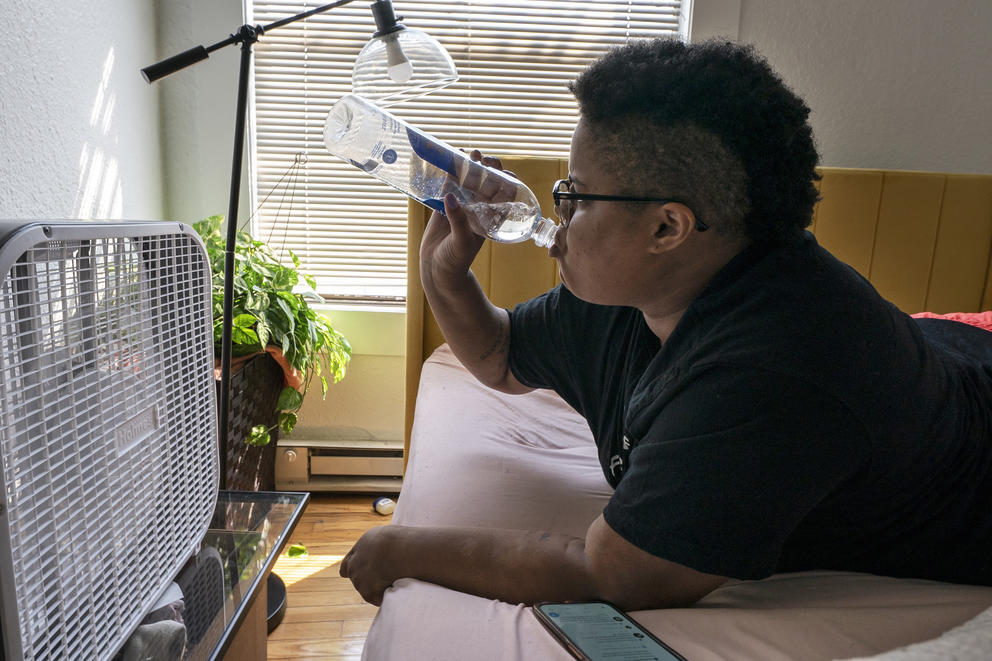Alexandra Rempel, an assistant professor of environmental studies at the University of Oregon, has been studying these passive cooling techniques for more than a decade. She has learned that by creating shade and natural ventilation at the right times of day — by opening, closing and shading windows and doors — people can significantly lower the temperature inside their homes, especially when pairing these approaches with fans.
Rempel recently led a groundbreaking study into ways that people in the Pacific Northwest could have benefited from passive cooling techniques during the record-breaking June 2021 heat wave.
The researchers found that in Pacific Northwest cities, passive cooling techniques could keep apartments below the danger threshold, lowering their peak indoor air temperatures by up to 25 degrees Fahrenheit compared to residents who did nothing. These efforts kept apartments on average between 10 and 15 degrees below outside temperatures.
“In our climate type, we have an extraordinary opportunity to meet our cooling needs without air conditioning. And we did not realize how great it was,” says Rempel, emphasizing that air conditioning is still relatively rare in the Pacific Northwest, despite being a critical safety feature.
Rempel offered the following tips for taking advantage of passive cooling, no matter your living situation.
Limit your electronics. In the Pacific Northwest, heat enters our homes through unshaded windows, but we also generate it inside our homes — and in our bodies. Cooking, running refrigerators, lights and appliances, surfing the web, and even just breathing increase our home temperatures. The more people use electronics at home, the more heat you have to worry about. Limiting your physical activity could also help you avoid heat stress, but it’s not necessary for reducing indoor air temperature — luckily our bodies produce much less heat than refrigerators and electronics.
Get the right shades. Part of the reason our heat wave in June 2021 was so intense, Rempel says, was that the days were clear, which increases solar radiation at ground level. “What that means is that the shades are really, really needed to keep that heat from getting inside the building,” she says. But not all shades are created equal.
- Consider shade shape. If you can, invest in interior shades that are cellular — or honeycomb — and that run along tracks on the sides of the window frame, which creates a seal, Rempel says: “That's very important to keep room air from circulating against the window and warming up.” Another valuable but less common and accessible window covering is external, like rolling bamboo blinds, which prevent light and heat from even getting to your window.
- Get the right color shades. Light-colored shades are more effective, because they’re better than darker colors at reflecting visible wavelengths — where about 40% of the sun’s energy goes.
Get better at throwing shade. Using shades at the right times of day significantly decreases indoor temperatures — but a lot of people don't know how to do this correctly.
- Shade any window that gets sun on it, while it has sun on it. That applies even to north- and east-facing windows early in the morning when it’s still cool. “It doesn’t feel warm yet necessarily … but that solar energy that comes from east windows stays with you all day,” Rempel says.
- Unshade sooner than you might think you need to. You don’t need to be a vampire to survive extreme heat. As soon as sunlight is not hitting a window — like an east window in the afternoon — go ahead and partly or fully unshade.
- Unshade at night, as soon as you don’t need shades for privacy. You can still wear your sunglasses at night if you really want to … but let your windows breathe. Unshaded window glass not only gathers solar heat, but helps radiate it outward, starting around dusk.
Cool your home before you think you need to. In the days leading up to extreme heat, try to keep your home as cool as possible. Rempel and her colleagues found that keeping your home closed up and unshaded in the days before temperatures peak can push homes into the danger zone. When a heat wave is forecast, Rempel says, start acting like it’s already here, and cool your home and belongings down in advance. “It will be chilly,” she says.
Say thanks for clear night skies. An unsung hero of heat wave safety is nighttime temperatures — one reason why a King County heat-mapping project in 2020 focused on heat differentials at night. Having access to cooler temperatures at night, which show up in places with cooling tree canopies and less pavement, helps people recover from hot daytime hours. That lack of trees and presence of pavement helps landscapes retain heat, creating what is known as the Heat Island Effect. The bigger the temperature difference between your window and a night sky, the better you’ll be able to offload heat when that window is unshaded.
“As soon as it’s cooler outside, open up the windows and get the air moving with a fan or whatever you need to keep that air going through the night,” Rempel says. Even during the heat wave, nighttime temperatures got into the 70s.
Unfortunately, nighttime temperatures are increasing even in King County and warming more rapidly than average temperatures, which concerns Rempel. “But it appears our resources are so substantial for now that we can do a lot to minimize air conditioning use while we still have time to try to get ahead of climate change,” she says. “Every bit of carbon that we avoid emitting now is, you know, a bit of urban heat island effects that are avoided.”
Invest in window security. Because keeping windows open at night is so useful, do what you can to make you feel safe leaving them open. Rempel recommends things like keys that let you lock windows from the inside, especially if you live at ground-level or have otherwise accessible windows; and to keep kids from falling out of them, put up barriers or open the windows only a bit.
Your decor is so hot right now. People are equally sensitive to air temperatures as they are to surface temperatures. That doesn’t mean you should get rid of heat-retaining objects like your leather sofa, but it does mean you need to be mindful that they heat up in the first place. “If the sun has come in and warmed up the tile floor, or even a wood floor or drywall materials, the temperature of these materials will make us feel warmer too even if the air is still cool,” Rempel says.
Know how to get a cross breeze going in any environment. The goal is to get a detectable cross breeze going for hours at a time.
If you only have windows on one side of your house, or your windows don’t open fully, open up as many as you can and pair them with a box fan to get air moving.
Know when to let outside breezes in, and when to let a fan take over. Before it gets warm outside, close your windows. “Air movement feels good when it’s, you know, 80 [degrees] outside and 75 inside. But then you’re starting to bring warm air in,” Rempel says. Research has shown that because of that, people are liable to leave windows open too long. The better strategy is to close your windows when it’s warm, and let your box fan circulate the cool air you’ve already brought inside.
Fan energy is minimal, so you’re not generating a lot of heat from using them — especially relative to how much comfort you gain in return. “The air movement accelerates evaporative heat loss from your skin. And so that feels really comfortable even if the windows are closed,” Rempel says. During a heat wave, that means closing windows for six to seven hours at a crack. It might get more humid and clammy inside until the evening, which doesn’t always feel great, but “that’s far better than bringing hot air inside,” she says, and reminds us that a little bit of fan energy can take the edge off.
When one door opens… close it. Close interior doors to trap heat in parts of your home. When the heat wave hit in Eugene, where Rempel lives, she didn’t have east window shading — but she did have bedroom doors. “We closed the bedroom doors so that the heat was at least trapped in the bedroom, and that helped enormously,” she says.
What about the smoke? PNW residents are unfortunately used to closing up their homes during smoke events. “Those fine particulates are incredibly toxic, and you definitely do not want to be naturally ventilating during those [events],” she says, and encourages people to rely on air purifiers. Rempel has looked into the relationship between extreme heat and smoke, and found a small silver lining. “I hate to use the word ‘fortunately’ in this scenario, but because smoke particles scatter solar energy so effectively, these two problems tend not to coincide” in the same place, she says.






